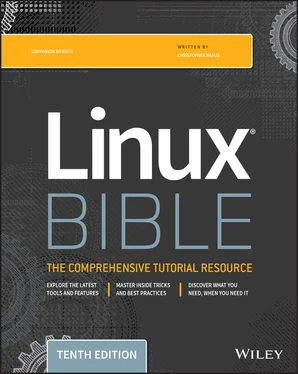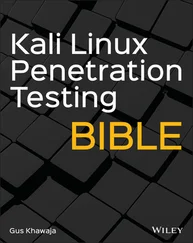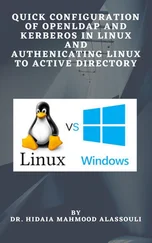1 ...8 9 10 12 13 14 ...54
Understanding How Linux Distributions Emerged
Having bundles of source code floating around the Internet that could be compiled and packaged into a Linux system worked well for geeks. More casual Linux users, however, needed a simpler way to put together a Linux system. To respond to that need, some of the best geeks began building their own Linux distributions.
A Linux distribution consists of the components needed to create a working Linux system and the procedures needed to get those components installed and running. Technically, Linux is really just what is referred to as the kernel . Before the kernel can be useful, you must have other software, such as basic commands (GNU utilities), services that you want to offer (such as remote login or web servers), and possibly a desktop interface and graphical applications. Then you must be able to gather all that together and install it on your computer's hard disk.
Slackware ( http://www.slackware.com) is one of the oldest Linux distributions still supported today. It made Linux friendly for less technical users by distributing software already compiled and grouped into packages. (Those packages of software components were in a format called tarballs .) Then you would use basic Linux commands to do things like format your disk, enable swap, and create user accounts.
Before long, many other Linux distributions were created. Some Linux distributions were created to meet special needs, such as KNOPPIX (a live CD Linux), Gentoo (a cool customizable Linux), and Mandrake (later called Mandriva, which was one of several desktop Linux distributions). But two major distributions rose to become the foundation for many other distributions: Red Hat Linux and Debian.
Choosing a Red Hat distribution
When Red Hat Linux appeared in the late 1990s, it quickly became the most popular Linux distribution for several reasons:
RPM package management: Tarballs are fine for dropping software on your computer, but they don't work as well when you want to update, remove, or even find out about that software. Red Hat created the RPM packaging format so that a software package could contain not only the files to be shared but also information about the package version, who created it, which files were documentation or configuration files, and when it was created. By installing software packaged in RPM format, you could store that information about each software package in a local RPM database. It became easy to find what was installed, update it, or remove it.
Simple installation: The Anaconda installer made it much simpler to install Linux. As a user, you could step through some simple questions, in most cases accepting defaults, to install Red Hat Linux.
Graphical administration: Red Hat added simple graphical tools to configure printers, add users, set time and date, and do other basic administrative tasks. As a result, desktop users could use a Linux system without even having to run commands.
For years, Red Hat Linux was the preferred Linux distribution for both Linux professionals and enthusiasts. Red Hat, Inc., gave away the source code, as well as the compiled, ready-to-run versions of Red Hat Linux (referred to as the binaries). But as the needs of its Linux community users and big-ticket customers began to move further apart, Red Hat abandoned Red Hat Linux and began developing two operating systems instead: Red Hat Enterprise Linux and Fedora.
Using Red Hat Enterprise Linux
In March 2012, Red Hat, Inc., became the first open source software company to bring in more than $1 billion in yearly revenue. It achieved that goal by building a set of products around Red Hat Enterprise Linux (RHEL) that would suit the needs of the most demanding enterprise computing environments. After expanding its product line to include many components of hybrid cloud computing, Red Hat was purchased by IBM in July 2019 for $34 billion.
While other Linux distributions focused on desktop systems or small business computing, RHEL worked on those features needed to handle mission-critical applications for big business and government. It built systems that could speed transactions for the world's largest financial exchanges and be deployed as clusters and virtual hosts.
Instead of just selling RHEL, Red Hat offers an ecosystem of benefits upon which Linux customers could draw. To use RHEL, customers buy subscriptions that they can use to deploy any version of RHEL that they desire. If they decommission a RHEL system, they can use the subscription to deploy another system.
Different levels of support are available for RHEL, depending on customer needs. Customers can be assured that, along with support, they can get hardware and third-party software that is certified to work with RHEL. They can get Red Hat consultants and engineers to help them put together the computing environments they need. They can also get training and certification exams for their employees (see the discussion of RHCE certification later in this chapter).
Red Hat has also added other products as natural extensions to Red Hat Enterprise Linux. JBoss is a middleware product for deploying Java-based applications to the Internet or company intranets. Red Hat Virtualization comprises the virtualization hosts, managers, and guest computers that allow you to install, run, manage, migrate, and decommission huge virtual computing environments.
In recent years, Red Hat has extended its portfolio into cloud computing. Red Hat OpenStack Platform and Red Hat Virtualization offer complete platforms for running and managing virtual machines. However, the technology with the biggest impact in recent years is Red Hat OpenShift , which provides a hybrid cloud suite of software that has Kubernetes, the most popular container orchestration platform project, as its foundation. With the Red Hat acquisition, IBM has set a goal to containerize most of its applications to run on OpenShift.
There are those who have tried to clone RHEL, using the freely available RHEL source code, rebuilding and rebranding it. Oracle Linux is built from source code for RHEL but currently offers an incompatible kernel. CentOS is a community-sponsored Linux distribution that is built from RHEL source code. Recently, Red Hat took over support of the CentOS project.
I've chosen to use Red Hat Enterprise Linux for many of the examples in this book because, if you want a career working on Linux systems, there is a huge demand for those who can administer RHEL systems. If you are starting out with Linux, however, Fedora can provide an excellent entry point to the same skills that you need to use and administer RHEL systems.
While RHEL is the commercial, stable, supported Linux distribution, Fedora is the free, cutting-edge Linux distribution that is sponsored by Red Hat, Inc. Fedora is the Linux system that Red Hat uses to engage the Linux development community and encourage those who want a free Linux for personal use and rapid development.
Fedora includes tens of thousands of software packages, many of which keep up with the latest available open source technology. As a user, you can try the latest Linux desktop, server, and administrative interfaces in Fedora for free. As a software developer, you can create and test your applications using the latest Linux kernel and development tools.
Because the focus of Fedora is on the latest technology, it focuses less on stability. So, expect that you might need to do some extra work to get everything working and that not all the software will be fully baked.
I recommend that you use Fedora or RHEL for most of the examples in this book for the following reasons:
Fedora is used as a proving ground for Red Hat Enterprise Linux. Red Hat tests many new applications in Fedora before committing them to RHEL. By using Fedora, you will learn the skills you need to work with features as they are being developed for Red Hat Enterprise Linux.
Читать дальше












